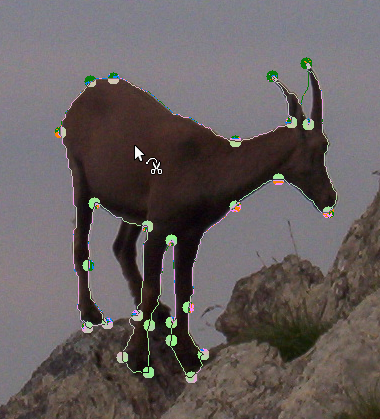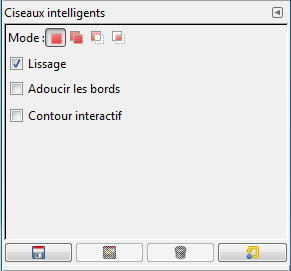The Scissors Select tool is an interesting piece of equipment: it has some features in common with Free Select, some features in common with the Path tool, and some features all its own. It is useful when you are trying to select a region defined by strong color-changes at the edges. To use the Scissors, you click to create a set of "control nodes", also referred to as anchors or control points, at the edges of the region you are trying to select. The tool produces a continuous curve passing through these control nodes, following any high-contrast edges it can find. If you are lucky, the path that the tool finds will correspond to the contour you are trying to select.
Unfortunately, there seem to be some problems with the edge-following logic for this tool, with the result that the selections it creates tend to be pretty crude in a lot of cases. A good way to clean them up is to switch to Quick Mask mode, and use paint tools to paint in the problematic parts. On the whole, most people find the Path tool to be more useful than the Scissors, because, even though it does not have the intelligent edge-finding capability, the paths it produces persist until you delete them, and can be altered at any time.
There are different possibilities to activate the tool:
-
From the main menu: → → .
-
By clicking the tool icon
in the Toolbox.
-
By pressing the I keyboard shortcut.
Le comportement par défaut des touches Maj, Ctrl, et Alt est décrit dans Section 2.1.1, « Touches de contrôle » pour tous les outils de sélection.
Il y a toutefois une touche de contrôle qui a un comportement particulier quand vous l’utilisez pour modifier une sélection, c’est après avoir ajouté le premier nœud :
- Shift
-
Par défaut, la fonction accrochage automatique est activée : si vous cliquez-glissez, l’outil trouve la limite de plus fort contraste de couleur pour s’y accrocher.
Le fait d’appuyer sur Maj désactive cette fonction et le nœud de contrôle sera placé à la position du pointeur de la souris.
Retour arrière supprime de dernier segment tracé, Échap supprime tous les segments de sélection.
Each time you left-click with the mouse, you create a new control point, which is connected to the last control point by a curve that tries to follow edges in the image. To finish, click on the first point (the cursor changes to indicate when you are in the right spot) or press the Enter key. You can adjust the curve by dragging the control points, or by clicking on the boundary of the curve to create new control points. When you are satisfied and want to convert the curve to a selection, click anywhere inside the curve or press the Enter key.
As said above when you click with this tool you drop points. The
selection boundary is driven by these control points. During creation you
can move each one by clicking and dragging, except the first and the last
one. The selection is closed when you are clicking the last point over
the first one. When the selection is closed the pointer shape
changes according to its position: inside
 ,
on the boundary
,
on the boundary
 ,
and outside
,
and outside
 .
You can adjust the selection creating new points by clicking on the
boundary or by moving each control points (merged first and last
point). The selection is validated when you click inside.
.
You can adjust the selection creating new points by clicking on the
boundary or by moving each control points (merged first and last
point). The selection is validated when you click inside.
À noter qu’on ne peut avoir qu’une seule sélection : si vous validez une seconde sélection, celle-ci remplacera la première qui sera sera effacée.
![[Avertissement]](images/warning.png)
|
Avertissement |
|---|---|
|
Faites bien attention à ne pas cliquer à l’intérieur de la courbe avant d’avoir fini de l’ajuster. Une fois qu’elle est transformée en sélection, la commande d’annulation efface tout et vous ramène à votre point de départ. Veillez aussi à ne pas sélectionner un autre outil, sous peine de perdre votre travail. Il vous reste néanmoins la possibilité de transformer votre courbe fermée en chemin et de la retravailler avec l’outil Chemins. |
Pour déplacer la sélection, voir Déplacer les sélections
Normally, tool options are displayed in a window attached under the Toolbox as soon as you activate a tool. If they are not, you can access them from the main menu through → → which opens the option window of the selected tool. The available tool options can also be accessed by double clicking the corresponding tool icon in the Toolbox.
- Mode, Lissage, Feather edges
-
![[Note]](images/note.png)
Note See Selection Tools Options for help with options that are common to all these tools. Only options that are specific to this tool are explained here.
- Contour interactif
-
Si cette option est activée, la ligne entre le point cliqué et le point précédent vous indiquera le contour de sélection avant de relâcher le bouton de la souris. Si l’option n’est pas activée, cette ligne sera droite et le contour de sélection ne s’inscrira qu’après avoir relâché le bouton de la souris, ce qui n’est intéressant qu’en cas d’ordinateur lent.





